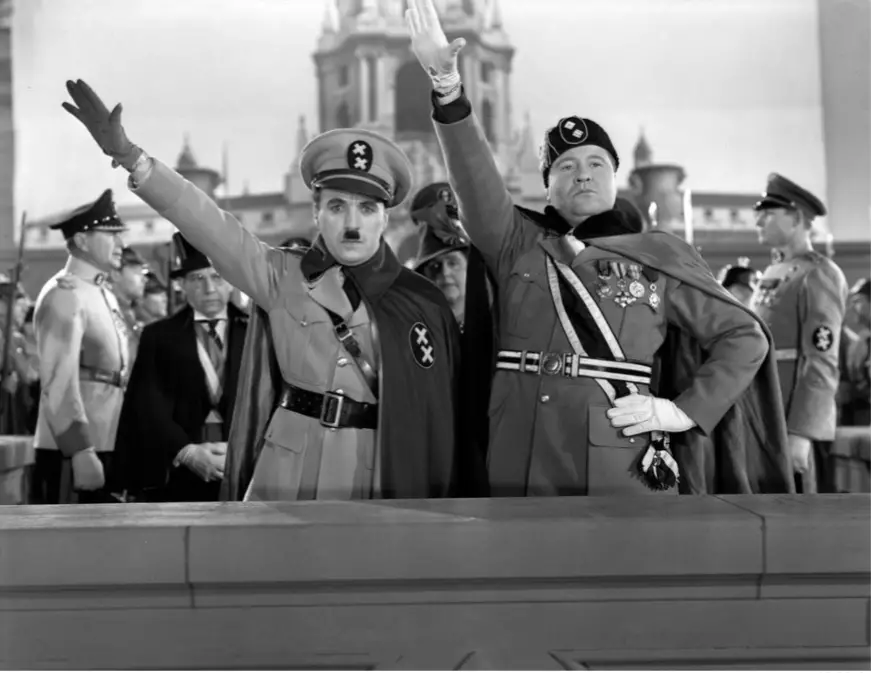 he film “The Great Dictator” was written and directed by Charles Chaplin, who also played the lead role. Released on the big screen on October 15, 1940, the film is a satire on Adolf Hitler and the Nazi regime. Chaplin’s film is exceptional, especially because, although filming began in 1937, it foreshadowed Hitler’s aggressive policy that led to World War II.
he film “The Great Dictator” was written and directed by Charles Chaplin, who also played the lead role. Released on the big screen on October 15, 1940, the film is a satire on Adolf Hitler and the Nazi regime. Chaplin’s film is exceptional, especially because, although filming began in 1937, it foreshadowed Hitler’s aggressive policy that led to World War II.
In the context of the year in which it appeared, the film proved an act of special courage not only because the United States, the place where Chaplin produced this film, was not in conflict with Nazi Germany, but also for portraying persecution of Jews across Europe. The film tried to represent the grim Nazi regime whilst being historical. The movie is also considered a piece of propaganda against fascism to American viewers.
From comedy to reality
“The Dictator” is a turning point in Chaplin’s artistic career. It is the first “spoken” film and the last of the vagabond Charlot, the one who consecrated the filmmaker, and last but not least, it is the first film in which Chaplin takes an explicit political position. In fact, his involvement in politics and the open expression of his visions of the left would have only brought trouble to the British director. Chaplin plays a double role in the film: that of the amnesiac Jewish barber — the tramp, and that of the dictator of Tomania, Adenoid Hynkel, a character modeled after Adolf Hitler.

The names of Hynkel’s aides are parodies of those of Hitler’s aides. Garbitsch, or Hynkel’s right hand, is very close in name to Joseph Goebbels, and Marshal Herring closely resembles the commander of the Luftwaffe Air Force, Hermann Göring. Benito Mussolini’s Italy named in the film Benzino Napaloni, an acronym after Napoleon Bonaparte is transformed into “Bacteria”, a name given to represent the initial source of fascism before World War 2.

The film contains many tasty and memorable comic scenes: the dance of dictator Hynkel with a balloon on which the globe is drawn in his office, the Jewish barber, who shaves a client on Brahms’ music in “Hungarian Dance no. 5 “, moving with the razor to the rhythm of the music and the speech of Hynkel, which represents a true caricature of the oratorical style of Adolf Hitler, studied very carefully by Chaplin.
Hitler responding to the movie
It seems that the film, banned in Nazi Germany, as well as in the states under its influence (including Romania), was seen by Adolf Hitler and the leaders of the Nazi regime. Nevertheless, they found the movie very updating as it tried to ridicule the Nazi Regime, but it also offered a taste to the Nazis of what the Americans were thinking of them. What they saw in their eyes was a nation that tried to ridicule Nazi Germany out of fear.

Other nations that were to be neutral in the Second World War criticized America at the beginning of the war and that comedy in the indirect form of propaganda is the only weapon America has against Nazi Germany. Nevertheless, the film offered a very accurate representation of how Hitler and Mussolini would lead their way into World War 2.
One great factor that the movie has to offer (in my opinion) is the inspirational as well as the motivational speech given by Charlie Chaplin as Hynkel. The speech actually tries to represent the opposite side of a fascist leader, one that would not see soldiers as cannon meat nor see other nationalities as inferior.
Avid Writer with invaluable knowledge of Humanity!
Upcoming historian with over 30 million views online.
“You make your own life.”





